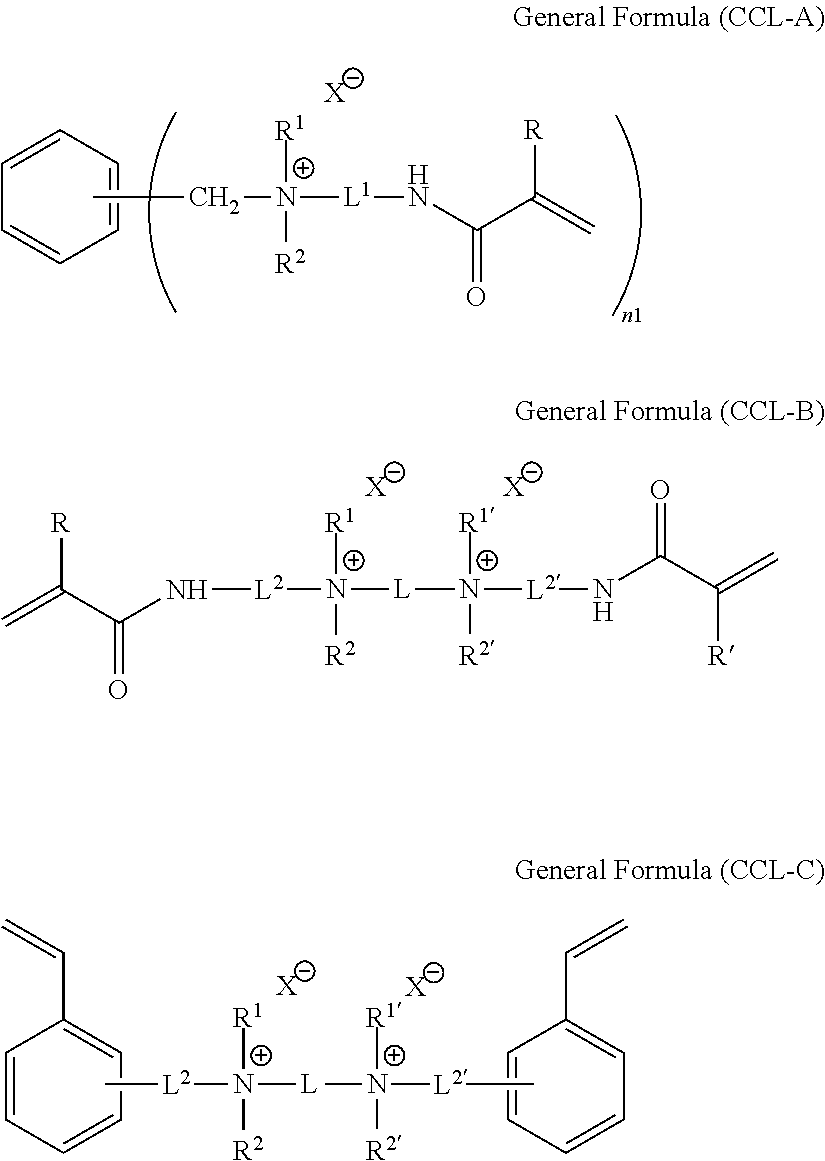Ion exchange membrane and method for manufacturing the same
a technology ion exchanger, which is applied in the field of ion exchange membrane, can solve the problems of difficult to obtain both low electrical resistance and achieve the effects of low electrical resistance, increased ion exchange capacity, and low water permeability
- Summary
- Abstract
- Description
- Claims
- Application Information
AI Technical Summary
Benefits of technology
Problems solved by technology
Method used
Image
Examples
example 1
[0251](Manufacturing of Anion Exchange Membrane by Photopolymerizing and Curing Reaction
[0252]1) Manufacturing of Anion Exchange Membrane
[0253]Each coating liquid of the ion exchange membrane forming compositions in the compositions (unit: g) of Table 1 below was used and manually applied to an aluminum plate at a speed of about 5 m / min, by using a wire bar of 150 μm (a stainless steel rod obtained by winding a wire of 150 μm by 1 cycle / 3 cm (length direction)), and subsequently the coating liquid was impregnated to nonwoven fiber (manufactured by Freudenberg Group, Product Name: FO-2223-10, thickness: 100 μm). The remaining coating liquid was removed by using a rod to which a wire was not wound. The temperature of the coating liquid at the time of application was about 50° C. The polymerizing and curing reaction was performed on the coating liquid impregnated support for the exposure time of 0.7 seconds and the polymerizing and curing time of 1.2 seconds by using an UV exposure mac...
example 2
[0292](Manufacturing of Anion Exchange Membrane by Thermal Polymerizing and Curing Reaction 1) Manufacturing of Anion Exchange Membrane
[0293]Each coating liquid of the ion exchange membrane forming compositions in the compositions (unit: g) of Table 2 below was used and manually applied to an aluminum plate at a speed of about 5 m / min, by using a wire bar of 150 μm (a stainless steel rod obtained by winding a wire of 150 μm by 1 cycle / 3 cm (length direction)), and subsequently the coating liquid was impregnated to nonwoven fiber (manufactured by Freudenberg Group, Product Name: FO-2223-10, thickness: 100 μm). The remaining coating liquid was removed by using a rod to which a wire was not wound. The temperature of the coating liquid at the time of application was about 50° C. Both sides of the support was interposed between polyethylene terephthalate films and heated at 80° C. for 4 hours, and anion exchange membranes were manufactured by performing polymerizing and curing reaction. ...
example 3
[0304](Manufacturing of Cation Exchange Membrane by Photopolymerizing and Curing Reaction) 1) Manufacturing of Cation Exchange Membrane
[0305]Each coating liquid of the ion exchange membrane forming compositions in the compositions (unit: g) of Table 3 below was used and manually applied to an aluminum plate at a speed of about 5 m / min, by using a wire bar of 150 μm (a stainless steel rod obtained by winding a wire of 150 μm by 1 cycle / 3 cm (length direction)), and subsequently the coating liquid was impregnated to nonwoven fiber (manufactured by Freudenberg Group, Product Name: FO-2223-10, thickness: 100 μm). The remaining coating liquid was removed by using a rod to which a wire was not wound. The temperature of the coating liquid at the time of application was about 50° C. The polymerizing and curing reaction was performed on the coating liquid impregnated support for the exposure time of 1.0 second and the polymerizing and curing time of 1.6 seconds, by using an UV exposure machi...
PUM
| Property | Measurement | Unit |
|---|---|---|
| thickness | aaaaa | aaaaa |
| thickness | aaaaa | aaaaa |
| thickness | aaaaa | aaaaa |
Abstract
Description
Claims
Application Information
 Login to View More
Login to View More - R&D
- Intellectual Property
- Life Sciences
- Materials
- Tech Scout
- Unparalleled Data Quality
- Higher Quality Content
- 60% Fewer Hallucinations
Browse by: Latest US Patents, China's latest patents, Technical Efficacy Thesaurus, Application Domain, Technology Topic, Popular Technical Reports.
© 2025 PatSnap. All rights reserved.Legal|Privacy policy|Modern Slavery Act Transparency Statement|Sitemap|About US| Contact US: help@patsnap.com



